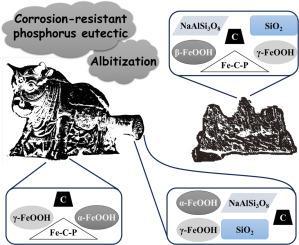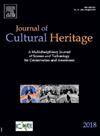山西普金渡遗址唐代铁牛腐蚀成分及机理研究
IF 3.3
2区 综合性期刊
0 ARCHAEOLOGY
引用次数: 0
摘要
山西浦金渡遗址的唐代铁牛(公元8世纪)由于环境风化而表现出严重的氧化降解,腐蚀剥落损害了它们作为考古冶金文物的美学和结构完整性。本研究采用共聚焦拉曼光谱、扫描电镜和能谱分析了铁牛组的三个腐蚀样品。目的是表征腐蚀产物的成分分布,阐明腐蚀-矿化相互作用。结果表明:低矿化腐蚀试样中主要含有α-FeOOH(针铁矿)、β-FeOOH(阿卡甘酸钾)、γ-FeOOH(鳞云母)和未腐蚀的三元磷化物共晶结构,在锈层内观察到明显的石墨聚集体。β-FeOOH的分布与氯(Cl)的分布有一定的相关性,正如预期的那样。高矿化腐蚀样品以α-FeOOH和Fe₂O₃(赤铁矿)为主,其中Fe₂O₃含量随着腐蚀深度的增加而降低。磷共晶结构(稳定体)表明,在碱性条件下,稳定体可以形成钝化膜,从而阻止进一步的腐蚀进程。有色金属矿物主要由二氧化硅(SiO₂)、钠长石(NaAlSi₃O₈)和方解石(CaCO₃)组成,二氧化硅主要分布在高度矿化的多孔铁锈层和宏观裂缝中。它们的形成机制可能反映了地质沉积过程中早期的地球化学过程——特别是钠长石化、硅化和钙化。本研究将浦金渡现场铁牛铸件缺陷与腐蚀产物分布联系起来,为腐蚀评价和保护优化提供依据。本文章由计算机程序翻译,如有差异,请以英文原文为准。

Corrosion components and mechanisms of the iron oxen of tang dynasty at Pujindu Site, Shanxi Province, China
The Tang Dynasty iron oxen (8th-century CE) at Pujindu Site, Shanxi, exhibit severe oxidative degradation from environmental weathering, with corrosion exfoliation compromising their aesthetic and structural integrity as archaeometallurgical artifacts. This study employed confocal Raman spectroscopy, SEM, and EDS to analyze three corrosion samples from the iron oxen group. The objectives were to characterize the compositional profiles of corrosion products and elucidate the corrosion-mineralization interplay. The results demonstrate that low-mineralization corrosion samples predominantly contain α-FeOOH (goethite), β-FeOOH (akaganéite), γ-FeOOH (lepidocrocite), and uncorroded ternary phosphide eutectic structures, with significant graphite aggregates observed within the rust layers. The distribution of β-FeOOH exhibits a certain correlation with that of chlorine (Cl), as expected given its chloride-incorporating nature. High-mineralization corrosion samples are dominated by α-FeOOH and Fe₂O₃ (hematite), where the Fe₂O₃ content decreases with increasing corrosion depth. The phosphorus eutectic structures (steadite) suggests that under alkaline conditions, steadite could form a passivation film, thereby halting further corrosion progression. The non-ferrous minerals are primarily composed of silica (SiO₂), albite (NaAlSi₃O₈), and calcite (CaCO₃), with silica predominantly distributed within highly mineralized porous rust layers and macroscopic fissures. Their formation mechanisms potentially reflect early-stage geochemical processes—specifically albitization, silicification, and calcification—during geological sedimentation. This study links casting defects in Pujindu Site iron oxen to corrosion product distribution, aiding corrosion assessment and conservation optimization.
求助全文
通过发布文献求助,成功后即可免费获取论文全文。
去求助
来源期刊

Journal of Cultural Heritage
综合性期刊-材料科学:综合
CiteScore
6.80
自引率
9.70%
发文量
166
审稿时长
52 days
期刊介绍:
The Journal of Cultural Heritage publishes original papers which comprise previously unpublished data and present innovative methods concerning all aspects of science and technology of cultural heritage as well as interpretation and theoretical issues related to preservation.
 求助内容:
求助内容: 应助结果提醒方式:
应助结果提醒方式:


